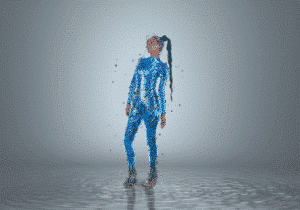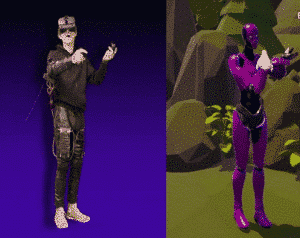In a pioneering effort, engineers at ETH Zurich are developing a remarkable suit called Meta Suit that promises to provide users with an unparalleled metaverse experience. Equipped with advanced sensors and soft, human-like muscles, this groundbreaking hybrid clothing enables natural interaction and immersion in virtual reality (VR). With the ability to track movements without relying on a camera system, the Meta Clothing is set to redefine the boundaries of virtual experiences. In this article, we explore the features, advantages, and working principles of the Meta Suit, shedding light on the remarkable innovations pioneered by the engineers at ETH Zurich.
What is the Meta Suit?
The Meta Suit, created by a group of eight mechanical engineering students from the Swiss Federal Institute of Technology, is a groundbreaking piece of clothing designed to enhance the metaverse experience. This tactile suit covers the entire body, incorporating artificial muscles known as Hasel (hydraulically amplified self-healing electrostatic actuators). The inclusion of multiple sensors and soft, human-like muscles enables users to interact more naturally with the virtual environment. By supercharging immersion in the metaverse, the Meta Suit offers a gateway to unprecedented levels of virtual reality engagement.
Advantages and Disadvantages of the Meta Suit

Advantages of the Meta Suit: |
Disadvantages of the Meta Suit: |
|
|
|
|
|
|
It’s important to note that these advantages and disadvantages are based on the current understanding of the Meta Suit’s development and may evolve as the technology progresses and further refinements are made.
How Does the Meta Suit Work?
At the core of the Meta Suit’s functionality lies the Hasel technology. The artificial muscles within the suit utilize a unique mechanism that mimics the contraction and expansion of human muscles. By applying a tiny electric current, similar to zip-lock bags, the muscles can contract and expand. This contraction and expansion generate haptic feedback, allowing users to “feel” the virtual environment. The muscles are created by filling pouches with a special fluid and applying a voltage to the electrodes, causing the muscles to contract. This groundbreaking technology has the potential to redefine the metaverse experience, bringing a sense of touch and realism to virtual interactions.
ETH Zurich: Pioneers of Innovation

ETH Zurich, the Swiss Federal Institute of Technology, is renowned for its contributions to groundbreaking research and technological advancements. The development of the Meta Suit is yet another testament to the institute’s commitment to pushing the boundaries of possibility. With a team of talented engineers, ETH Zurich continues to drive innovation and shape the future of technology.
Unveiling the Meta Suit
Developed by a team of eight mechanical engineering students from the Swiss Federal Institute of Technology, the Meta Suit aims to enhance the user’s VR experience through the integration of cutting-edge technology. Unlike traditional VR setups that rely on external cameras for tracking, this suit employs multiple sensors embedded throughout its fabric to precisely monitor and map the wearer’s movements.
Artificial Muscles: The Heart of the Meta Suit
At the core of the Meta Suit lies a revolutionary technology known as hydraulically amplified self-healing electrostatic actuators (Hasel). These artificial muscles mimic the properties and behavior of human muscles, enabling users to have a more natural and intuitive interaction with the virtual environment.
The Hasel technology operates by utilizing a tiny electric current to induce contraction and expansion in the muscles. This is achieved through pouches filled with a special fluid, upon which electrodes are sprayed. By applying a voltage to these electrodes, the muscles contract, leading to a realistic haptic feedback experience. The wearer can “feel” objects and textures in the virtual world as the muscles on the suit respond accordingly.
Enhancing Immersion in the Metaverse
The metaverse, a virtual 3D space for social interactions, gaming, and virtual events, has always faced a challenge in replicating the sense of touch. The Meta Suit aims to overcome this limitation by allowing users to experience haptic feedback, bringing virtual objects to life. This breakthrough technology promises to elevate the overall immersion and realism of the metaverse experience.
Transforming Metaverse Use Cases
Traditional VR headsets, such as the recently unveiled Apple Vision Pro, have often been criticized for their lack of haptic feedback, limiting the sense of realism. However, the Meta Clothing has demonstrated its potential to revolutionize these use cases. In a test metaverse experience, users wearing the suit were able to feel a bird landing on their hand, creating an astonishingly realistic sensation.
Project Lead Maximilian Eberlein expressed his excitement, highlighting the transformative nature of the Meta Suit. He emphasized the suit’s ability to transport users to entirely different environments, such as Mars, where they can interact and genuinely “feel” objects in a way never experienced before.
The Future of the Metaverse

The development of the Meta Suit represents a significant step forward in the evolution of virtual reality and the metaverse. By incorporating artificial muscles and haptic feedback, this innovative technology has the potential to redefine the way we interact with digital spaces and objects. The Meta Suit’s immersive capabilities hold promise not only for entertainment and gaming but also for industries such as education, healthcare, and training simulations.
Conclusion
The Meta Suit represents a significant leap forward in the quest for immersive metaverse experiences. Engineered by the talented team at ETH Zurich, this hybrid clothing equipped with artificial muscles and sensors has the potential to revolutionize virtual reality. By enabling natural interaction, haptic feedback, and intuitive movement tracking, the Meta Clothing bridges the gap between physical and virtual worlds. Although challenges such as cost, comfort, and practicality remain, the Meta Suit showcases the incredible potential of technology to create transformative experiences within the metaverse. As research and development progress, the Meta Clothing may soon pave the way for a new era of immersive virtual reality.
Frequently Asked Questions about Meta Suit:
The Meta Suit is a groundbreaking piece of clothing developed by engineers at ETH Zurich. It is designed to enhance the metaverse experience by incorporating advanced sensors and soft, human-like muscles. The suit allows users to have more natural interaction with virtual reality and provides haptic feedback, enabling them to feel the virtual environment.
Meta suits are designed to be customizable and adjustable to fit different body sizes and shapes. However, the suitability of a meta-suit for an individual may depend on factors such as physical condition, specific requirements, and training. In certain cases, individuals with certain medical conditions or physical limitations may not be able to use meta clothing.
The Meta Suit utilizes artificial muscles called Hasel (hydraulically amplified self-healing electrostatic actuators) to mimic the movements and sensations of human muscles. These muscles contract and expand using a small electric current, similar to a zip-lock bag mechanism. The suit is equipped with multiple sensors that track and map the wearer’s movements, allowing for seamless interaction within the metaverse.
The Meta Suit offers several advantages for users. Firstly, it enables more natural and immersive interaction with virtual reality, enhancing the overall metaverse experience. Additionally, the suit provides haptic feedback, allowing users to feel virtual objects and environments. This brings a new level of realism and engagement to virtual reality applications. Furthermore, the Meta Suit’s ability to track movements without relying on a camera system ensures a more intuitive and seamless user experience.
While the Meta Suit offers remarkable features, there are some limitations. The complexity of the suit’s design and the integration of multiple sensors and actuators make it a sophisticated piece of technology. This complexity may increase the production cost and potentially impact the comfort and usability of the suit. These aspects need to be further optimized to ensure widespread adoption and practicality.
The Meta Suit is being developed by a team of eight mechanical engineering students from ETH Zurich, the Swiss Federal Institute of Technology. ETH Zurich is renowned for its pioneering research and technological advancements, and the development of the Meta Clothing exemplifies its commitment to pushing the boundaries of virtual reality technology.
The metaverse is a virtual 3D space where users can interact through gaming, virtual events, and social activities. It is an immersive virtual environment that aims to replicate the real world or create entirely new digital realms. The metaverse allows users to explore, connect, and engage with others in a virtual setting.



